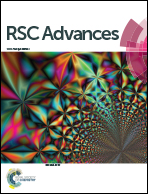Synthesis and photovoltaic properties of A–D–A type non-fullerene acceptors containing isoindigo terminal units
Abstract
Four solution-processable acceptor–donor–acceptor (A–D–A) structured organic molecules with isoindigo as terminal acceptor units and different aromatic rigid planar cores such as indacenodithiophene (IDT), dithienosilole (DTS), anthracene, and pyrene as donor units, namely P1, P2, P3, and P4, respectively, were designed and synthesized as the acceptor materials in organic solar cells (OSCs). The four compounds possess a broad absorption covering the wavelength range of 400–700 nm and a rather high-lying LUMO energy level, which is beneficial for achieving a high open circuit voltage (Voc). P1 and P2 with IDT and DTS central cores demonstrate stronger absorbance than the compounds P3 and P4 with anthracene and pyrene cores. A power conversion efficiency (PCE) of 1.39% was achieved for the OSC based on P1 as the acceptor material and P3HT as the donor material (1 : 1, w/w), which is the highest value for polymer bulk-heterojunction OSCs based on isoindigo small molecules as non-fullerene acceptors. The current results have demonstrated that isoindigo could be a useful building block for the synthesis of promising acceptor materials for OSCs.


 Please wait while we load your content...
Please wait while we load your content...